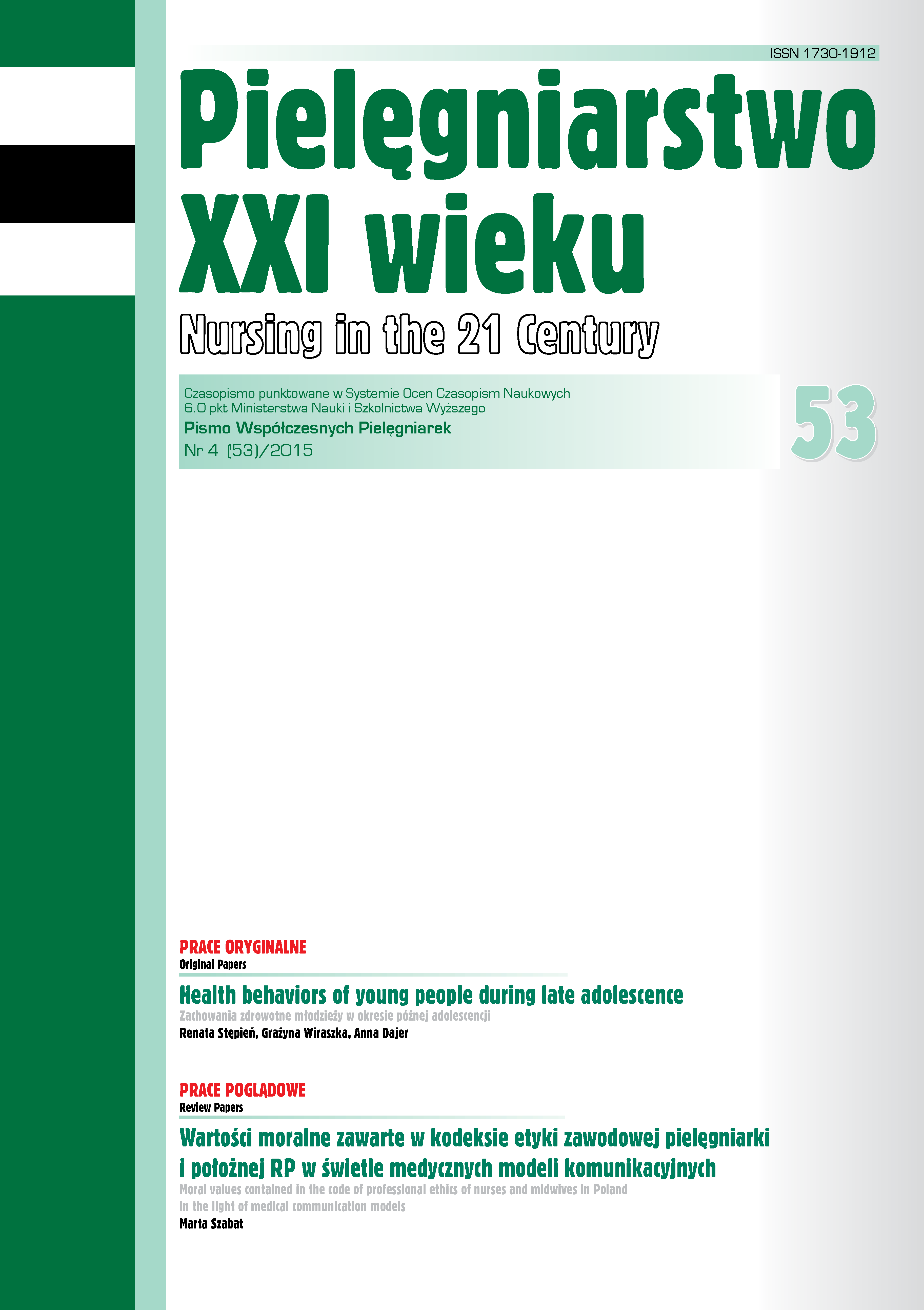Moral values contained in the code of professional ethics of nurses and midwives in Poland in the light of medical communication models
DOI:
https://doi.org/10.12923/p21w-2015-4/59Keywords:
ethics, communication, responsibilityAbstract
MORAL VALUES CONTAINED IN THE CODE OF PROFESSIONAL ETHICS OF NURSES AND MIDWIVES IN POLAND IN THE LIGHT OF MEDICAL COMMUNICATION MODELS
Introduction. The practical realization of moral values contained in the code of professional ethics for nursing (such as: respect for the patient, care for their dignity, intimacy, reliable completion of professional duties) is an integral part of nurses’ professional practice and involves picking a specific, individually tailored model of communicating with patients. Appropriate communication significantly affects the quality of nursing care.
Aim. Assessment of the feasibility of moral values contained in the code of professional ethics in the context of individual models of communication (taking into account the following models: biomedical, holistic, humanistic).
Material and Methodology. Hermeneutical method, whereby through a comparative analysis of the content of the code of professional ethics for nurses and midwives in Poland with the assumptions of specific communication models confirms the theory that a relationship between nursing staff and patients may become a basis for building nursing professional competence based on medical expertise.
Results. The biomedical model is rarely referred to in the code of professional ethics. The best expressions of moral values are the humanistic and holistic models. In the humanistic model, nursing staff can have a relationship with a patient and can demonstrate an empathetic attitude as well as introduce elements of conversation to the interview – a reference to the Special Parts of the Code, I. Nurse/midwife and patient, paragraphs 1-2, 7-8. In the holistic model, nursing staff and the patient are one another’s partners and their relationships are based on responsibility, maturity, respect for dignity and autonomy. This assumption corresponds to the point 3-6, 9 of the Special Parts of the Code, I. Nurse/midwife and patient.
Conclusions. The moral values contained in the text of the code of professional ethics for nurses and midwives in Poland can be realized most fully in humanistic and holistic models.
References
1. http://www.nipip.pl/index.php/samorzad/informacje-o-samorzadzie/2135-kodeks-etyki-zawodowej-pielegniarki-i-poloznej-rzeczypospolitej-polskiej (dostęp: 23.08.2015).
2. Gulla A. Creating Values in Life. Personal, Moral, Spiritual, Family and Social Values. Liberty Drive Bloomington. Indiana: Bloomington; 2010.
3. Hurley P. Consequentialising and Deontologising: Clogging the Consequentialist Vacuum, Oxford Studies in Normative Ethics. 2013; vol. 3: 123-153.
4. Gastmans Ch. Dignity-enhancing nursing care: A foundational ethical framework, Nursing Ethics. 2013; 20 (2): 141-149.
5. Nawrocka A. Etos w zawodach medycznych. Kraków: Wydawnictwo WAM; 2008. s. 99-115, 252, 256, 258-273.
6. http://nipip.pl/index.php/uchwaly/krajowych-zjazdow/iv-krajowego-zjazdupielegniarek-i-poloznych/uchwaly/896-9-04-2003 (dostęp: 23.08.2015).
7. Ostrzyżek A, Marcinkowski JT. Biomedyczny versus holistyczny model zdrowia a teoria i praktyka kliniczna, Problemy Higieny i Epidemiologii. 2012; 93(4): 682-686.
8. Kowalski M, Gaweł A. Zdrowie-wartość-edukacja. Kraków: Oficyna Wydawnicza „Impuls”; 2006. s. 16-17.
9. http://www.who.int/topics/nursing/en/ [dostęp: 25.08.2015].
10. Mazurek J. Fizjoterapia holistyczna, czyli psycho-fizjoterapia. Część III: Człowiek w fizjoterapii, czyli od modelu biomedycznego, przez humanistyczny, do holistycznego, Fizjoterapia. 2009; 17 (4): 90.
11. Gastmans Ch. Care as a Moral Attitude in Nursing, Nursing Ethics. 1999; 6 (3): 214-223.
12. http://www.ptb.org.pl/pdf/dobrowolska_cegielko_klauzula_1.pdf [dostęp: 25.08.2015]
13. Beauchamp TL, Childress JF. Zasady etyki medycznej, przeł. W. Jacórzyński, Warszawa: Książka i Wiedza, 1996. s. 72-80. Review match
Downloads
Published
Issue
Section
License
Copyright (c) 2015 Marta Szabat (Autor)

This work is licensed under a Creative Commons Attribution 4.0 International License.




